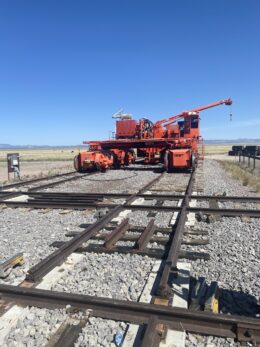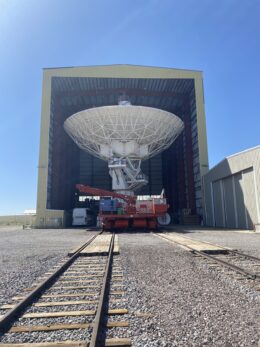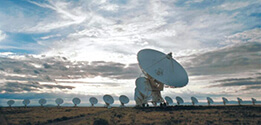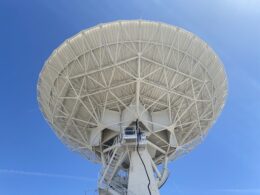What has 28 dishes, changes size every four months, and surveys the sky day and night? The Very Large Array, of course! After the conclusion of the 242nd AAS meeting in Albuquerque, NM, AAS Media Fellow Ben Cassese and I joined members of the media for a tour of this exceptional facility.
A Telescopic Tour
The Very Large Array, or VLA, is a premier radio astronomy observatory located two hours south of Albuquerque in the Plains of San Agustin. The VLA’s storied history began in the 1960s, when astronomers began to push for an array of radio dishes to complement the science being done with single dishes like the ones at Green Bank and Arecibo. Science operations at the VLA began in 1976. The VLA’s dishes work together as an interferometer, in which signals from multiple telescopes are combined to give the sensitivity of a single dish with an area equal to the combined area of the dishes in the array and the resolution of a single dish as wide as the largest distance between dishes in the array.The VLA is sited on a flat expanse of desert surrounded by mountains, and the dry climate, high altitude, and isolation from civilization make it an ideal location for a radio observatory. The isolation is necessary because of the dishes’ sensitivity, which makes them vulnerable to terrestrial radio interference — compare the strength of a typical 5-Watt cellphone signal from someone standing nearby to a 10-23 W/m2/Hz signal from a distant galaxy. Luckily, having multiple dishes working together provides another defense: signals spotted by only some of the antennas or that arrive at some antennas before the rest are suppressed.

To enter or exit the maintenance barn, the antenna-laden transporter must execute a 90-degree turn. [Kerry Hensley]
Astronomers who use the VLA for research will be familiar with the process of applying for time on the array and eagerly awaiting the data if time is awarded — but what goes on behind the scenes to support our science?
Getting a Bird’s-Eye View

Dish number 28 undergoing maintenance in the antenna assembly barn. Remarkably, there are only three points of contact between the base of the antenna and the transporter. [Kerry Hensley]
Next, we were treated to a rare opportunity: climbing into one of the dishes! After donning mandatory hard hats, our group scaled a narrow metal staircase that zigzagged up to the top of the support structure — not recommended if you have an intense fear of heights — and emerged through a trapdoor into the dish itself.

Media Fellow Ben Cassese and I staying cool (and taking in the very cool views!) up in the dish. Hard hat required, sunglasses highly recommended! [Kerry Hensley]

A panoramic view from up in the dish. The receivers are visible jutting out from the surface of the disk. [Kerry Hensley]
What’s Next for the VLA?
The next phase for the VLA, known as the Next Generation VLA or ngVLA, will include 263 antennas spread across 500 miles. Because of the immense distances involved, the dishes can no longer travel back to the barn when maintenance is needed. Instead, technicians will need to meet the dishes where they are, as far afield as Hawaii, Puerto Rico, and New Hampshire.

An artist’s impression of the ngVLA. [Sophia Dagnello, NRAO/AUI/NSF; CC BY 3.0]
Visitation Information
If visiting the VLA sounds fun to you, you’re in luck — the VLA is open to the public 362 days a year with guided tours on the first and third Saturdays of each month. Unfortunately, the antenna climb isn’t part of the standard tour package! Visitation details can be found here.



